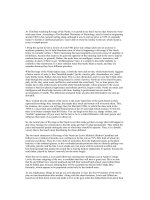the first movie stars florence lawrence mary pickford douglas fairbanks and charlie chaplin
Bạn đang xem bản rút gọn của tài liệu. Xem và tải ngay bản đầy đủ của tài liệu tại đây (38.12 KB, 2 trang )
Movie stars are actors whose personas transcends their work, that is, persons whose personas
becomes part of our mass culture. Several of the very first movie starts set the pattern for all those
who followed.
In the very early days of the Silent Film era however, there were no movie stars. The studios
purposely did not publicize their actors, since to do so might encourage them to demand more
money. That changed forever with Florence Lawrence, a former Vaudevillian, and America's first
movie star. She began to work in films in 1907, and moved to D.W. Griffith's Biograph studio in
1909. She starred in 65 films there that year and became very popular although the credits merely
read, as was custom, "The Biograph Girl". Carl Laemmle was starting his new Independent
Motion Picture Company in 1910 and wanted Lawrence as his "IMP" Girl. The public was
fascinated and demanded to know her identity. Laemmle shrewdly began to use her name and
picture in publicity and publicity stunts. Kelly R. Brown, in her 1999 biography of Lawrence
states: "Florence Lawrence was the first player, male or female, to use her name to advertise not
only a single motion picture, but also the production company she worked for. The company, in
turn, was able to place more films into theaters because the public wanted to see the films she was
in."
Thus was born the star system.
Once the public learned about Florence, they wanted to know about the other favorite players on
the screen. Other studios saw the advantage of this new kind of publicity, and in 1911 The Motion
Picture Story Magazine was launched to publicize Vitagraph's actors and film releases, followed
closely by Moving Picture Stories, and Photoplay. The studio's publicity departments refined
their trade and began to expand in order to fulfill the public's growing desire for any news,
professional and personal, about films and players.
As the decade progressed, American society began to move away from late Victorian values
toward the Jazz Age. Movie stars and their public persona also changed with the times.
Mary Pickford, who had replaced Lawrence as "The Biograph Girl", is a good example of this.
She soon became "Little Mary", and "America's Sweetheart" while starred in numerous films like
Rebecca of Sunnybrook Farm (1917) and Heart o' the Hills (1919). Her screen persona was that
of a child-like sprite, but that was in sharp contrast to her sophistication and business acumen in
her private life. By the mid 1910s, she was writing and producing films. In 1919 she co founded,
along with Douglas Fairbanks, Charles Chaplin, and D. W. Griffith, the United Artists
Corporation, and later was one of 36 founders of the Academy of Motion Picture Arts and
Sciences. The media portrayed her as a modern woman with whom her fans could identify, and
her public accepted both her public and screen personas.
Douglas Fairbanks was another early star. Famous for early films as the prototype of the
All-American Boy, he gained international fame for his swashbuckling roles during the 1920s. His
public and screen persona: energetic, athletic, exuberant, and supremely self-confident, quickly
made him an idol to millions of boys. His marriage to Mary Pickford in 1920 made them the
virtual king and queen of Hollywood. Their famous mansion in Beverly Hills, Pickfair, became
famous in the movie magazines as the center of Hollywood society.
Charlie Chaplin soon gained immense international fame that extended well past the coming of
sound. His screen persona, The Tramp, was a downtrodden little fellow blessed with eternal
optimism in the face of adversity. Everyone could identify and be inspired by him. Leonard
Maltin calls Chaplin the "single most influential artist in the history of motion pictures", who
"helped make the motion picture a medium of emotional expression, taking it forever out of the
category of a mere flickering novelty".
Pickford's, Fairbanks', and Chaplin's rising popularity can be tracked with their rising salaries.
Pickford's 1909 salary was $10 per day, which rose to $10,000 per week by 1915. Fairbanks and
Chaplin also started with the usual studio salaries for unknown, untried stars, but were also
making $10,000 per week by 1916. By 1919, all three stars were receiving $150,000 each along
with a percentage of the box-office returns on each of their exceedingly popular films.
Other stars soon eclipsed Florence Lawrence, and she faded from the limelight by 1916. Mary
Pickford and Douglas Fairbanks were famous and made pictures into the 30s. Charlie Chaplin's
fame has scarcely faded, even though he made very few films after 1940. His films are still
studied and enjoyed today. These stars, from the first two decades of the American Film Industry,
truly presaged the kind of fame achieved by all their successors.









